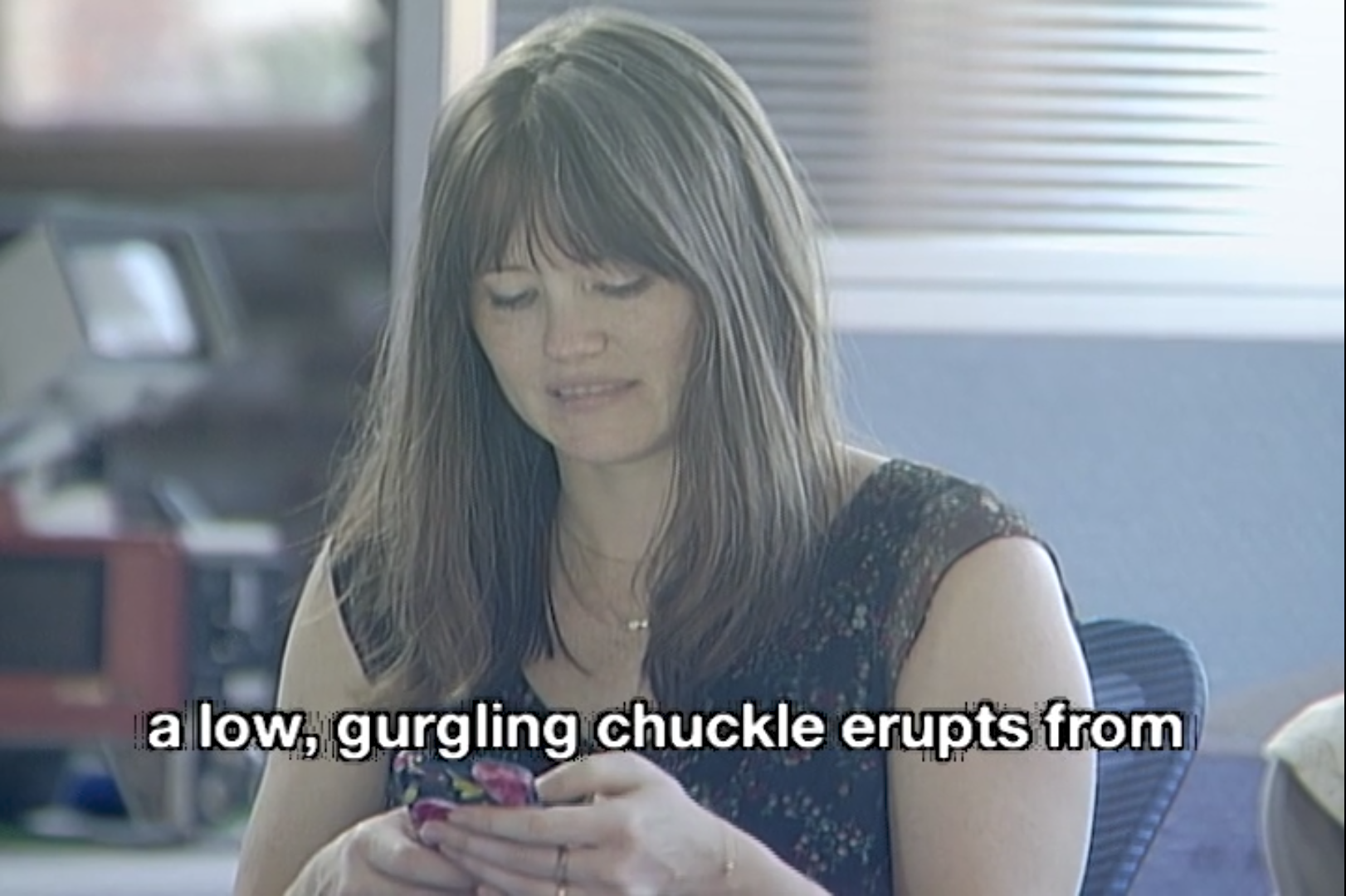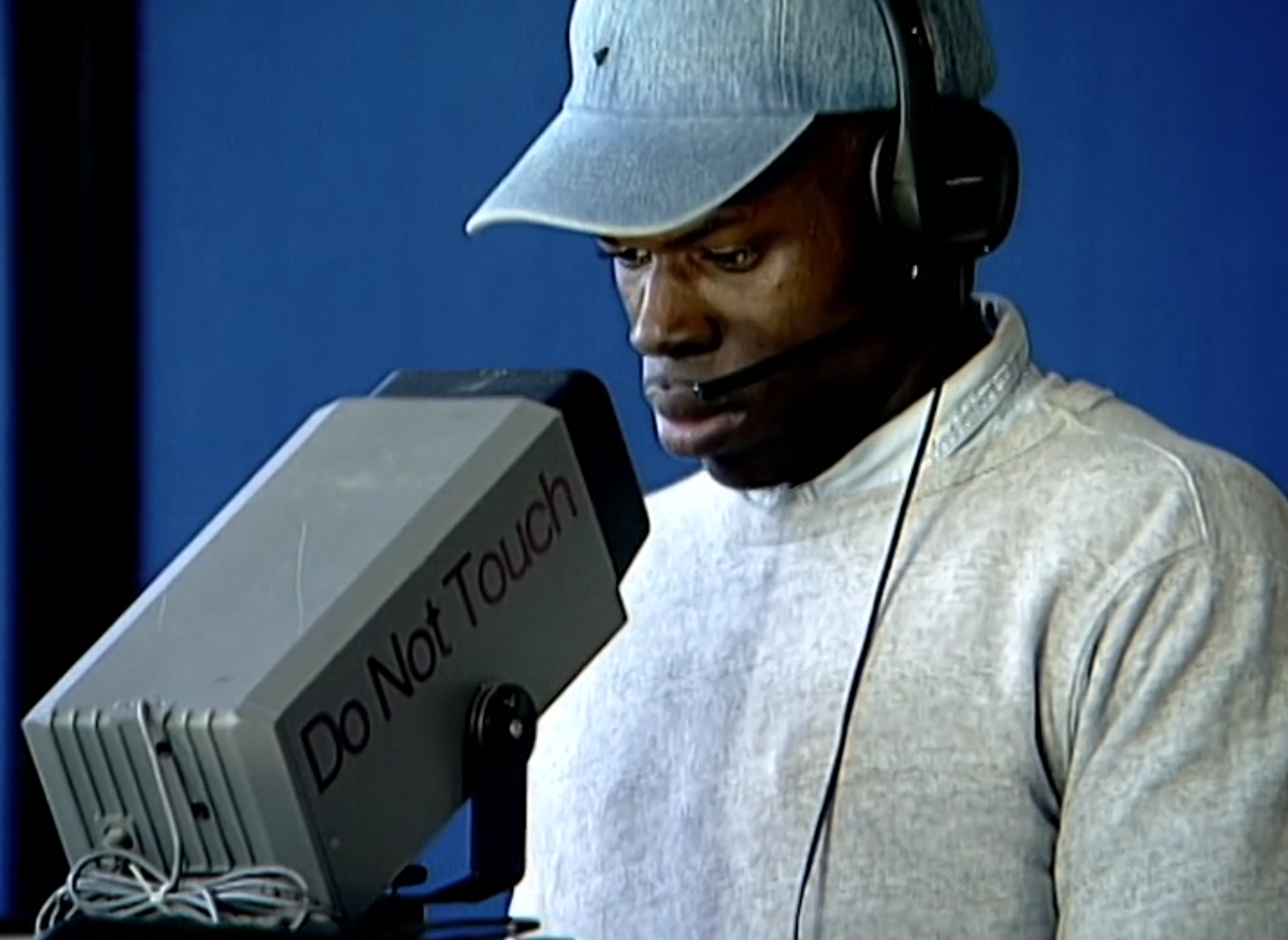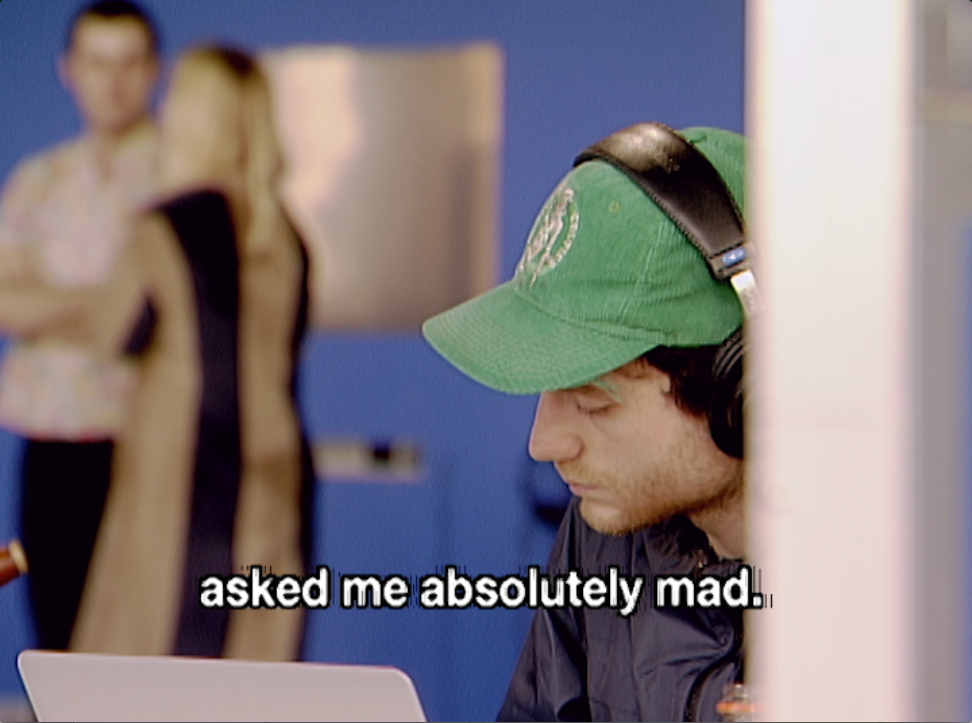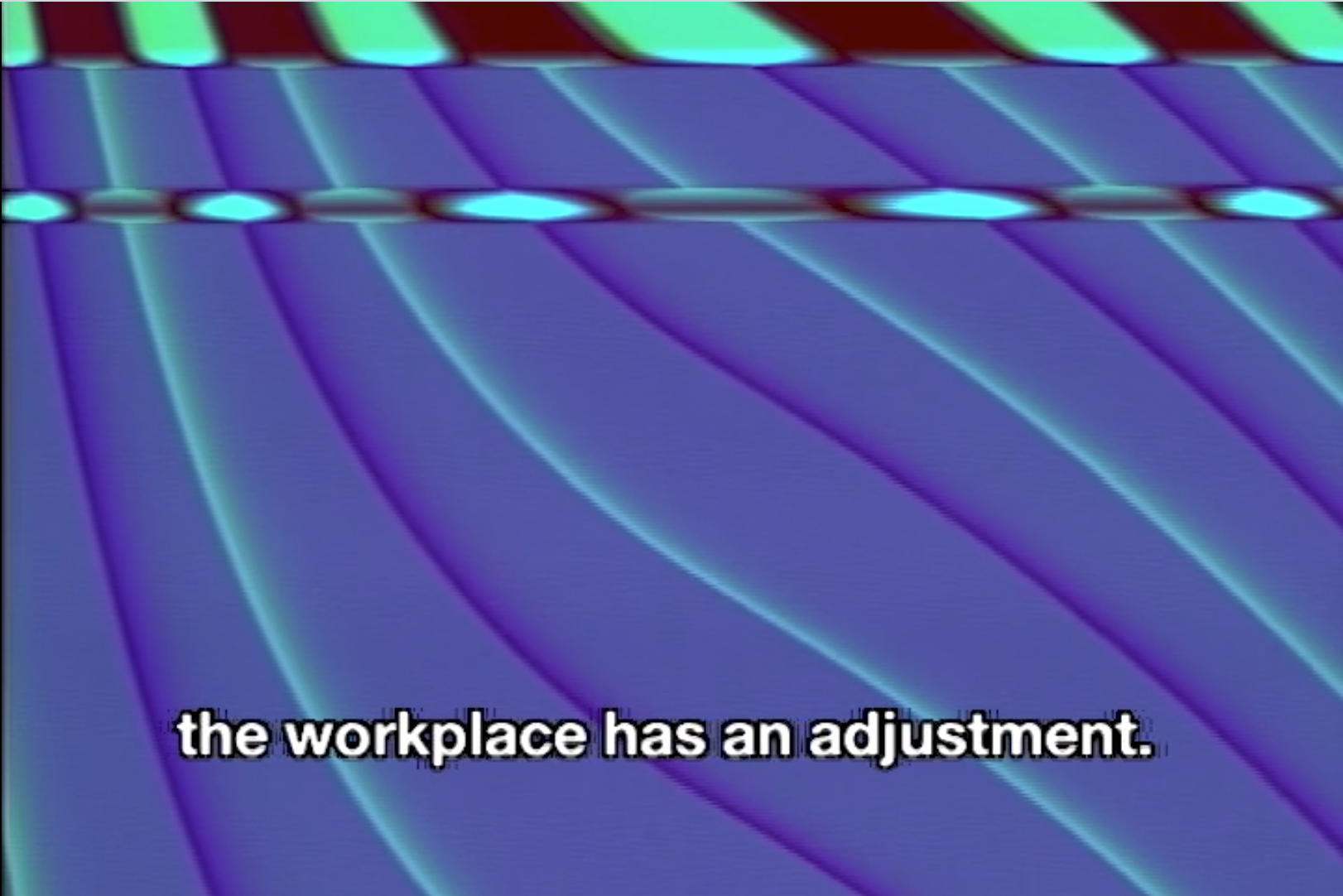Ten 30- to 60-second videos from 1991, conceived as interventions into commercial television, interrupted the usual flow of advertising and entertainment when broadcast nightly in British Columbia for three weeks in 1992. These micronarratives mimic televisions editing techniques, but as kernels of a story they refuse to cohere. They are tales of dysfunction and dislocation, misanthropy and misunderstanding. When the videos were aired unannounced during commercial breaks, viewers called the station to inquire about what was being sold, their responses evincing how the media can refocus attention from content to consumption.
Televisual Art
"Double Dip Concession", Auto Italia LIVE
AUTO ITALIA LIVE: DOUBLE DIP CONCESSION
Paul Becker, Nathan Budzinski, Benedict Drew, Robert Carter, Andrew Kerton, Leslie Kulesh, Huw Lemmey, o F F Love, Francesco Pedraglio, Lorenzo Tebano, Jess Weisner
Auto Italia South East presents Auto Italia LIVE: Double Dip Concession, an artist-run Live TV show performed before a studio audience and broadcast over the internet. Working in collaboration with Auto Italia, artists are developing new work for this one-off episode which engages directly with the format of live television. This new episode is commissioned by the ICA as part of Remote Control and will be broadcast live from the ICA Theatre.
This episode will use the techniques, characters and editing of live television to explore our interaction with the flow of images that invade our lives. Exploring the individual relationship that the audience has with broadcast, we consider the possibility for a personal and autobiographical tone to be delivered within a context which alienates those present on the screen from accurate self-representation. The manufactured space created by the set will be the backdrop for actions, statements and performances which are commonplace in live TV production but are rarely broadcast to the viewers.
This project is engaging directly in contemporary broadcast culture as a space for new work and how physical communities use the Internet to distribute ideas. It aims to be a proposal for how artists can produce live broadcast work in collaboration and act as a unique place for artists to create their collective context and distribute their work.
Produced in collaboration with: Nikki Bevan, Giorgio Bosisio, Anna Brecon, Roderick Burrows, Nat Cary, Cristen Clague-Reading, Luke Collins, Theo Cook, Cameron Foote, Mette Juhl, Fran Hitchcock, Julia Innocenti, McDeath, Tim McFarland, Kate Molins, Celia Moodie, George Moustakas Elly Nakajima, Radiance Audio, Sonia Rodriguez Serrano, Rebecca Root, Bernard Thompson
With special thanks to: Lauren Barnes, Marleen Boschen, Paul Crompton, Aoife Flynn, Henry Petrides, Laurence Price, Matt Welch
Commissioned and produced by Auto Italia South East.
"Test Tube", General Idea, 1979
1979, 28:15 min, color, sound
Produced by De Appel, Amsterdam, while General Idea was in residence there, Test Tube was conceived as a program for television. Presented under the brand "The Color Bar Lounge," a cocktail bar in the mythical 1984 Miss General Idea Pavilion, the program is a hybrid of popular television formats, including talk show, soap opera, news magazine, and infomercial. Introducing the program, the artists-cum-media hosts pitch The Color Bar as a "cultural laboratory," serving up curative potions in test tubes in a lounge environment. Advertisements for the bar are placed throughout the program; a loaded word choice, full of double-entendres and innuendo, betrays the influence of both Dadaism and consumerism. This collapse of popular and high culture is central to General Idea's agenda, as Felix Partz observes: "You know, the mass media are like a vast pharmaceutical complex developing new cultural elixirs of an unprecedented intoxication...but art remains a curious and elitist drink. Despite its unique flavor and heady cultural properties, it has never effectively been exploited."
Interspersed throughout the program is a soap opera narrative about an isolated painter, a stay-at-home mother who troubles over exhibiting her art publicly. A modernist, "abstract depressionist," she provides a clear counterpoint to the artistic model cultivated by General Idea - though it is an ambivalent portrayal. Test Tube was produced at the close of the 1970s and is a prescient meditation on changes in the art world. In the end, her show sells out to rave reviews, and a phone call from her gallerist to the hosts of The Color Bar Lounge is answered with enthusiasm.
Producer: De Appel. Consultant: Joes Odufre. Also featuring: Marina Abramovic, Bob Du Buy, Robert Handforth, Raul Marroquin, Bill Panko, Tom Puckey, Wies Smals, Louwrien Wyers. Camera: Frits Oostvogel. Video: Jack Vreeburg, Harre Van Der Maat. Recorded at Cinevideo, Cmoep Holland. Sponsored by CRM.
"Via Los Angeles", Michael Asher, 1976
From Situation Aesthetics, The Work of Michael Asher, by Kirsi Peltomaki, 2010, MIT Press
Documentation of the live feed of the control room at kgw (radio and television). (Photograph courtesy the artist.)
“…Three years later, in January 1976, Asher explored the affective thresholds of normalcy by devising a television program that literally turned the camera back onto itself by filming the scene of production in the control room of the television station, and broadcasting the footage of the backstage activities to viewers at home. Produced with the support of the Portland Center for the Visual Arts in Portland, Oregon, as Asher’s contribution to the exhibition “Via Los Angeles,” the program aired as an episode in the regularly scheduled arts program Eight Lively Arts on kgw-tv at one o’clock on a Sunday afternoon. “Andy Warhol should have been in Portland Sunday,” declared the local newspaper Oregonian on its front page the following day. “He would have appreciated the Michael Asher ‘visual art’ presentation on kgw-tv. Numerous viewers didn’t.
They thought it was ‘an accident.’ ”During the Asher broadcast, the station’s telephone feedback line received around 140 phone calls about the program.
Some of the callers, disturbed by the situation, wished to alert the station to the fact that there were technical problems with the broadcast. “[O]ne call came from a television technician… who, thinking there was a faulty transmission, called the station to let us know that there was a camera in the master-control area,” Asher recounted. “A number of other callers… also communicated the same observation, some of them noticeably upset.” Although the act of calling kgw-tv to notify it of a perceived problem might have been an altruistic deed resulting in no immediate personal gain, it might also have been prompted by a more acute psychological need. The tone of the calls underscored the viewers’ urge to protect the television station from error—as they perceived Asher’s backstage view to be—and their desire to prompt the station into restoring normalcy to the broadcast. Ultimately, this impulse might have been linked to the caller’s own identity, to the degree that the caller’s sense of normalcy was affirmed by recognizable television content.
Although it would be easy to stereotype the Portland callers as cultural dupes who were naive or ill-informed because they missed the point of Asher’s project, such a reading would miss the power of personal response that Asher’s program unleashed within the callers.64 The callers were perfectly aware of the normative boundary that the project unseated when it crossed over the lines of conventional broadcasting. Immediate feelings of anxiety became more than ambient affective states when these reactions turned into acts of calling the station. The perceived irregularity of Asher’s program moved these television viewers into attempts to correct the situation and restore normalcy to what they considered normatively irregular television content. Their experience of the project was based upon par- ticular forms of cultural knowledge, assumptions, and rules, but these collec- tive aspects were modulated by individual response. The experience of the work mobilized in these viewers what Foucault might call relations to self and others, relations that were articulated in the emotional and practical care these viewers demonstrated in attempting to remedy the situation.”
E.S.P. TV: Work
For WORK, E.S.P. TV made Pioneer Works’ office staff and environment the subject of a six-week performative, televisual installation by relocating the organization’s second-floor, open-plan office to the first-floor’s main exhibition space. Surrounded by a de-centralized control room, the office doubled as both a dynamic sculptural set—painted partly in chroma blue and featuring movable walls, among other features—and the actual site for the staff’s five-day workweek. The staff’s “daily grind” was mixed live, on-site, with custom video effects and hourly commercial interruptions in the space. Far from peddling in the sensational tropes of reality TV, WORK instead turned banal, day-to-day office routines and patterns—the movement of a chair, a co-worker getting coffee—into the improbable, playful content of a serial program to be broadcast weekly on the Manhattan Neighborhood Network. E.S.P. TV worked closely with curator David Everitt Howe to envision this social experiment and exhibition, which responded to the building’s unique environment and tight-knit, collective office culture.
Recreated as a pastiche of a “contemporary” office, the installation featured a series of sculptural set pieces that could be activated in real-time or through the video editing process. A camera crew, live TV mixing consoles, monitors, and program feeds surrounded and permeated the working office. At the start of each workday, Pioneer Works staff functioned as both employees and cast members who “logged-in” to an evolving algorithm that combined their names with a glossary of camera shots and an office etiquette handbook. The resulting text generate an abstract script or textual narrative that informed both the episodes’ editing and their subtitles.


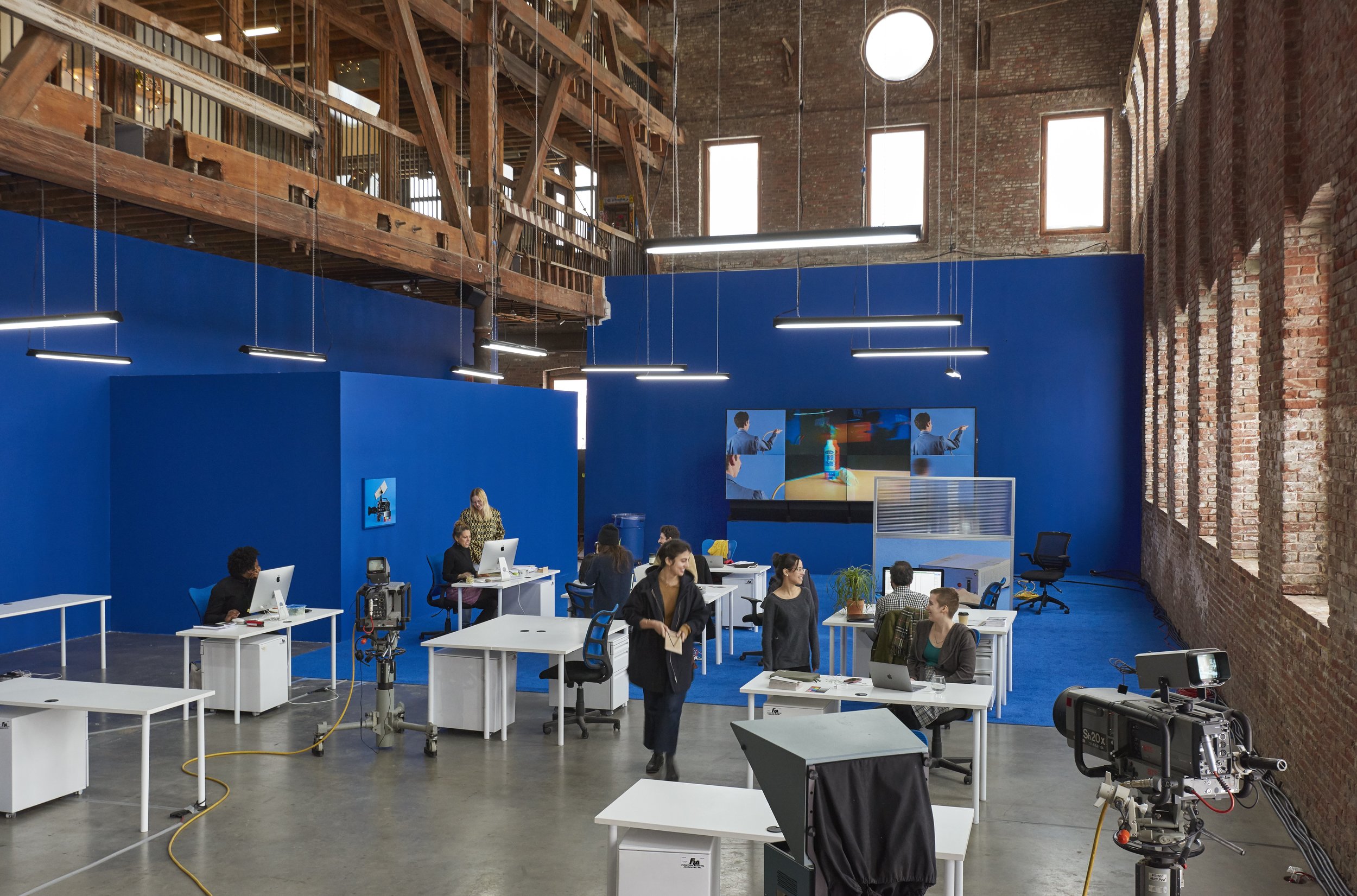
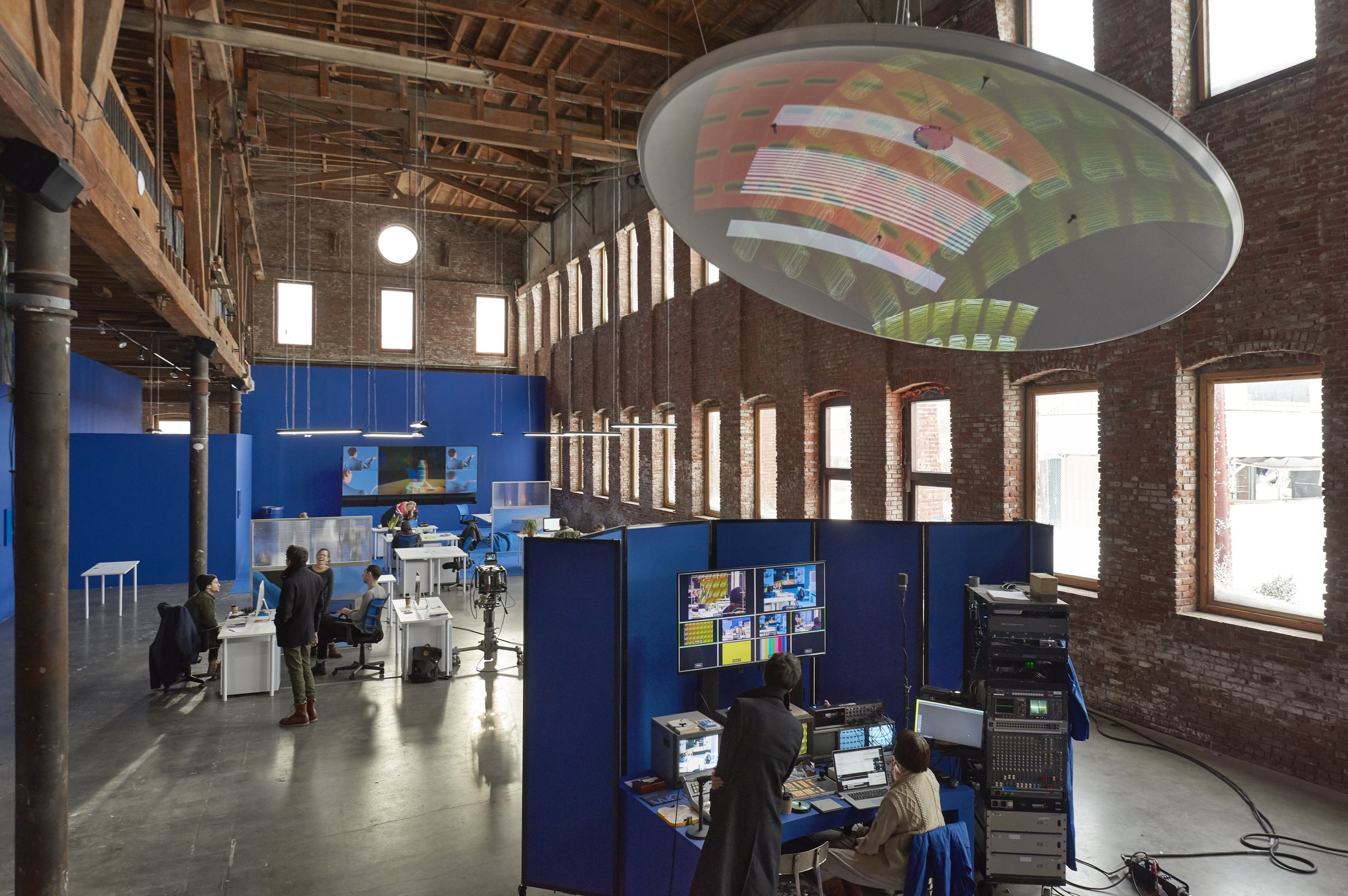
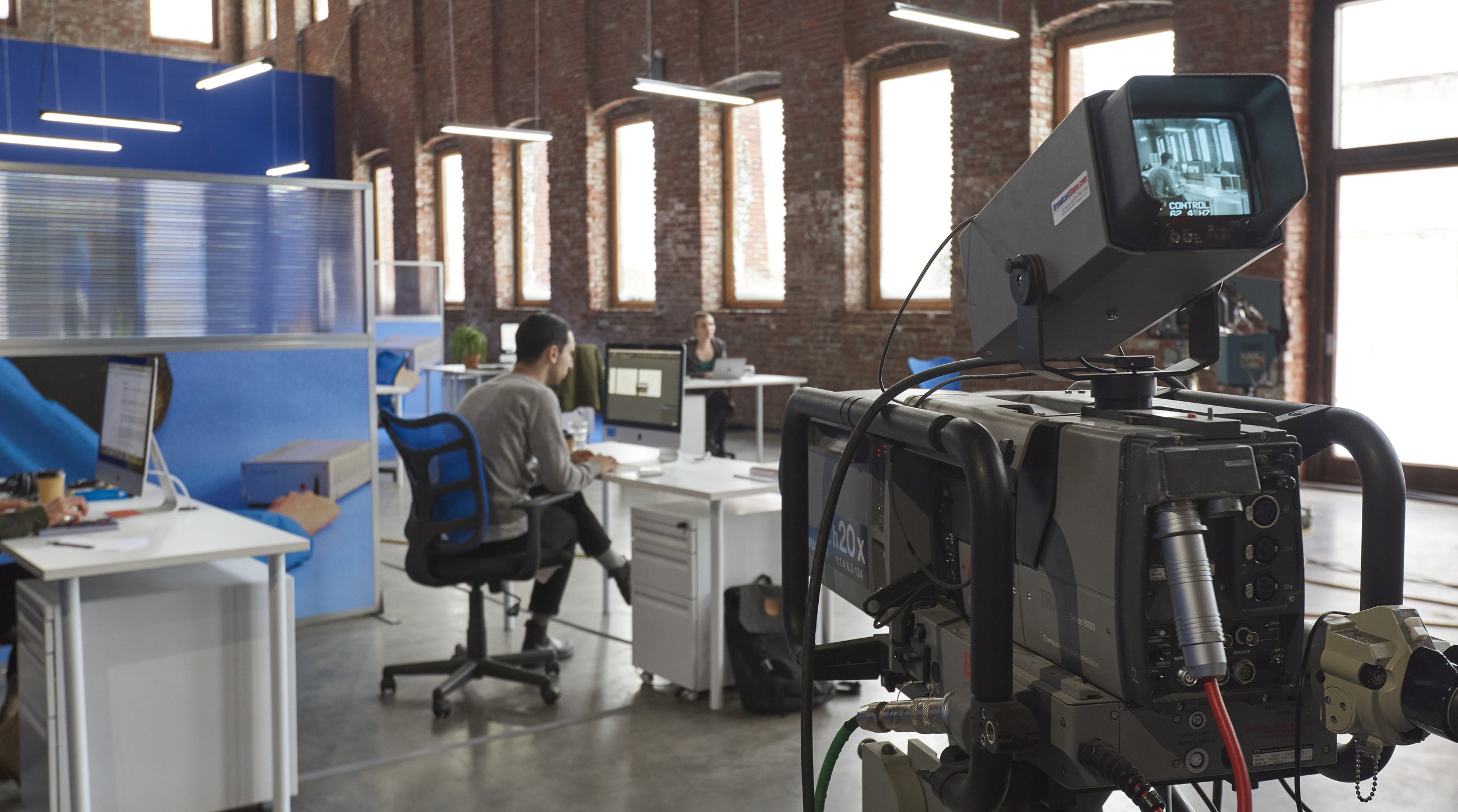

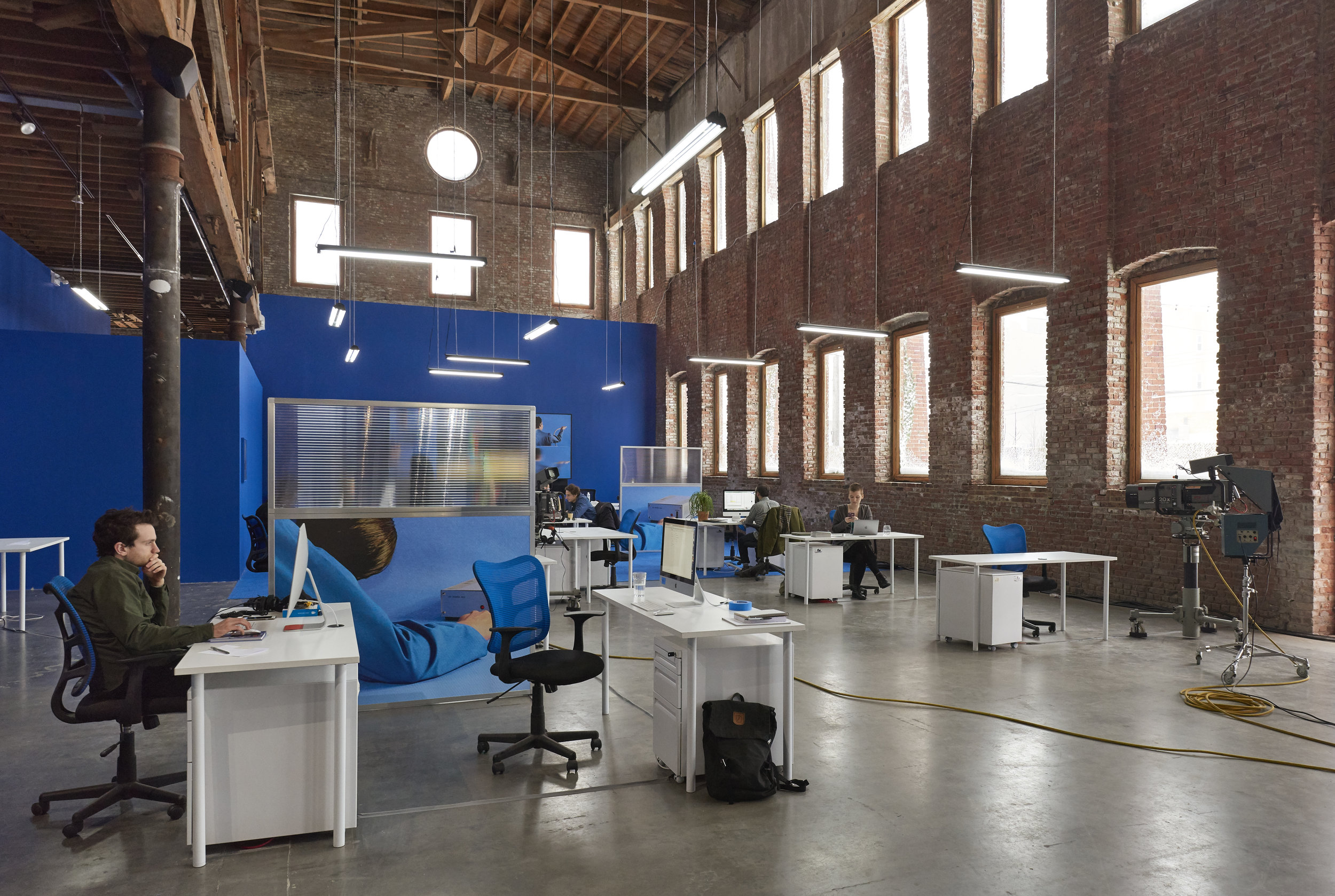
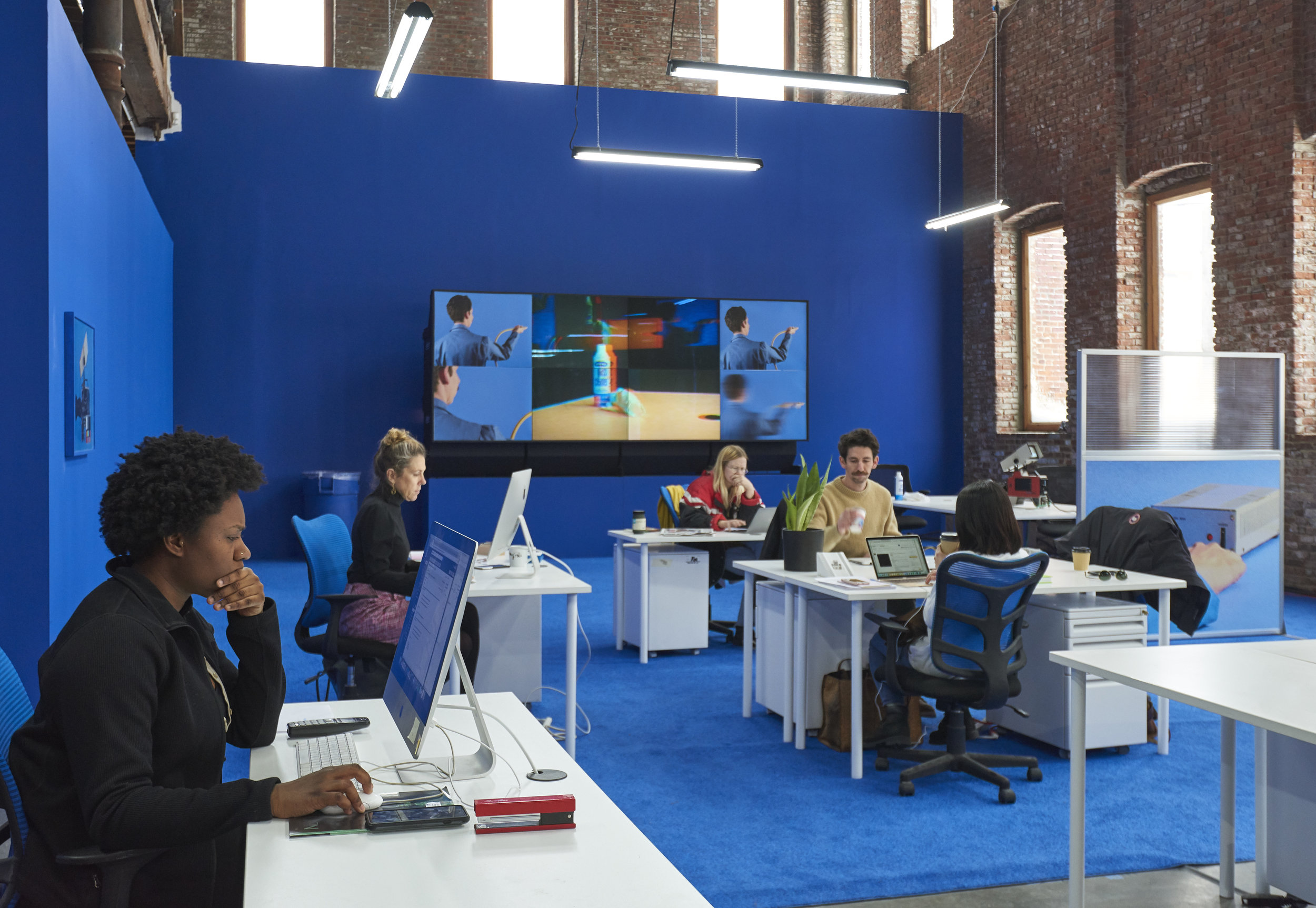
Working within galleries, museums, and artist-run and public spaces, E.S.P. TV’s television programs are taped before a live audience and place the labor of production in an equal spotlight with the artists and performers with whom they collaborate. These tapings reveal a new space born through a breakdown in the hierarchy of the producer and performer and an investigation of the aesthetic qualities of the “live TV studio set”—arising from subtle relationships of staging, timing, layers of observation and the line between shadow and shade of an evenly lit set. In many ways, the humorous, inquisitive, and convention-defying nature of E.S.P. TV carries on the tradition of institutional critique artists like Michael Asher. In the 1970s, Asher engaged in an art practice that broke down the separation between traditional roles of art production, exhibition, and public dissemination. An influential touchstone for E.S.P TV’s WORK is Asher's Via Los Angeles (1976) in which Asher recorded, and later broadcast, the behind-the-scenes interior of a local TV control room (Portland NBC affiliate KGW) while they were airing the Super Bowl.
For additional context, WORK featured video and printed ephemera from E.S.P. TV’s first 100 Episodes and 6 seasons on air in New York City. This multi-media collection draws on hundreds of collaborative efforts with local and international artists working in performance, video, sound, social practice, and more. Evoking this history, as well as the history of television and sound, a series of public programs featured screenings, performances, and an artist-led “staff retreat” to expound upon the major themes of the exhibition and activate the set outside of normal working hours.
Robert Ashley: Perfect Lives
PERFECT LIVES — an opera for television by Robert Ashley
I. The Park (Privacy Rules)
II. The Supermarket (Famous People)
III. The Bank (Victimless Crime)
IV. The Bar (Differences)
V. The Living Room (The Solutions)
VI. The Church (After the Fact)
VII.The Backyard (T'Be Continued)
Raoul de Noget (No-zhay), a singer, and his friend, Buddy, “The World’s Greatest Piano Player,” have come to a small town in the Midwest to entertain at The Perfect Lives Lounge. For some reason, unexplained, they have fallen in with two people from the town, Isolde (“nearing 30 and not yet spoken for”) and her brother, “D,” just out of high school and known as “The Captain of the Football Team” (his parents call him Donnie), to commit the perfect crime, a metaphor for something philosophical: in this case, to remove a sizable amount of money from The Bank for one day (one day only) and “let the whole world know that it was missing.”
Robert Ashley (March 28, 1930 – March 3, 2014) was an American composer, who was best known for his operas and other theatrical works, many of which incorporate electronics and extended techniques.
Ashley was born in Ann Arbor, Michigan. He studied at the University of Michigan with Ross Lee Finney, at the Manhattan School of Music, and was later a musician in the US Army. After moving back to Michigan, Ashley worked at the University of Michigan’s Speech Research Laboratories. Although he was not officially a student in the acoustic research program there, he was offered the chance to obtain a doctorate, but turned it down to pursue his music.[1] From 1961 to 1969, he organised the ONCE Festival in Ann Arbor with Roger Reynolds, Gordon Mumma, and other local composers and artists. He was a co-founder of the ONCE Group, as well as a member of the Sonic Arts Union, which also included David Behrman, Alvin Lucier, and Gordon Mumma. In 1969 he became director of the San Francisco Tape Music Center. In the 1970s he directed the Mills College Center for Contemporary Music. His notable students include Maggi Payne.
Jaime Davidovich
Jaime Davidovich (born in 1936) is an Argentine-American conceptual artist and television-art pioneer. His innovative artworks and art-making activities produced several distinct professional reputations including painter, installation artist, video artist, Public-access television cable TV producer, activist, and non-profit organizer. He is the creator of legendary downtown Manhattan cable television program The Live! Show (1979-1984). Billed as “the variety show of the avant-garde,” The Live! Show was an eclectic half-hour of live, interactive artistic entertainment inspired by the Dada performance club Cabaret Voltaire and the anarchic humor of American television comedian Ernie Kovacs.
The emergence of portable video equipment in the late 1960s dovetailed with Davidovich’s existing interest in minimalism and the aesthetics of line. Davidovich’s single channel video works “Road” in 1972 and “3 Mercer Street” in 1975 are some of his earliest video art explorations. These works are noteworthy because of their institutional backing; “Road” was produced with the assistance of the Akron Art Institute in Ohio and “3 Mercer Street” was made possible by a grant from the Creative Arts Public Service (CAPS) program. Davidovich then went on to create video installations, including his “Evita” works that developed between 1984–1992 and “Inside and Between” a 1996 work shown at El Museo del Barrio in New York City.
When cable television emerged in the mid-1970s, Jaime Davidovich was one of the first artists to recognize its potential for the contemporary arts. In 1976 he helped establish Cable SoHo. A year later he established the Artists Television Network, a nonprofit organization established to explore the artistic potential of broadcast television and encourage the dissemination of video art through a commercial broadcast medium. The organization produced television programming under the name SoHo Television, a Project of the Artists Television Network, and broadcast on Manhattan public-access television cable TV. Programming included video art, early music videos, performances and interviews with artists including Laurie Anderson, John Cage, and Richard Foreman among many others. The organization produced programming until 1984.
Davidovich is perhaps best known for his work on The Live! Show, a weekly public-access television program with a variety show format that appropriated the formal norms of television along with avant-garde performances, artwork, political satire, and social commentary. The program featured interviews and performance work by visiting artists, including Laurie Anderson, Eric Bogosian, Tony Oursler, and Michael Smith, along with musical performances, ersatz commercials, and viewer participation via live call-in segments. Presiding over the show’s disparate collaborative elements was Davidovich’s own satirical character, “Dr. Videovich, specialist in curing television addiction,” whom the New York Times’ television critic John J. O’Connor described as “a persona somewhere between Bela Lugosi and Andy Kaufman.” The show also featured commercials for Videokitsch, commercially produced items and art multiples made by Davidovich and others. Of The Live! Show, one critic notes, “Davidovich’s humor obviously transcends his medium, resulting in a comment as potent today as one assumes it was in 1972—harnessing new media to capture what is ‘real’ and 'true’ is an artistic act both vitally important and profoundly absurd.” In 1991 the American Museum of the Moving Image presented a retrospective of The Live! Show. In 2007 the Museo Nacional Centro de Arte Reina Sofía in Spain added The Live! Show to its collection of video art.







